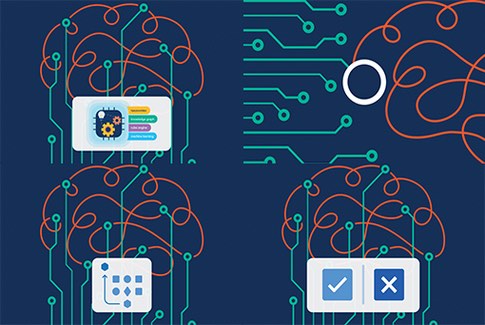
Natural language processing (NLP) solves a common business problem: unstructured data. More than 2.5 quintillion bytes of data are generated daily, but only 10%–20% is machine readable. The rest, close to 90%, is unusable unstructured data. This includes language data within PDFs, email, audio, video, chatbot, social media, and image files.
NLP helps machines understand unstructured language data so it can be optimized at scale and insights can be transformed into intelligence. With so much business potential, it is no surprise that 33% of tech leaders increased their NLP budgets by 30%, and 15% doubled theirs.
NLP is part of a broader digitization strategy, helping machines read unstructured data through advanced language analysis and processing. Here’s how NLP solves the unstructured data problem.
NLP Makes Unstructured Data Machine Readable
Natural language processing is a branch of computer science and artificial intelligence (AI) that allows computers to understand text using computational linguistics and rules-based modeling of human language. More simply, NLP enables machines to recognize characters, words and sentences, then apply meaning and understanding to that information. This helps machines to understand language as humans do.
NLP Analyzes Unstructured Text Data
For natural language processing to help machines understand human language, it must go through speech recognition, natural language understanding and machine translation. It is an iterative process comprised of several layers of text analysis, including:
- Morphological Level: Morphemes are the smallest units of meaning within words, and this level deals with morphemes in their role as the parts that make up a word.
- Lexical Level: This level of speech analysis examines how the parts of words (morphemes) combine to make words and how slight differences can dramatically change the meaning of the final word.
- Syntactic Level: This level focuses on the text at the sentence level. Syntax revolves around the idea that, in most languages, the meaning of a sentence is dependent on word order and dependency
- Semantic Level: Semantics focuses on how the context of words within a sentence helps determine their meaning on an individual level.
- Discourse Level: Discourse reveals how sentences relate to one another. Sentence order and arrangement can affect the meaning of the sentences.
- Pragmatic Level: Pragmatic analysis bases the meaning of words or sentences on situational awareness and world knowledge. Basically, what meaning is most likely and would make the most sense.
NLP Uses AI to Process Language
Text analysis is only part of the NLP process. For machines to truly understand words in context, they need to be able to disambiguate language at a human-like level. The level at which you are able to disambiguate language depends on your approach to artificial intelligence.
- Symbolic Approach: The symbolic approach to NLP is based on human-developed rules and lexicons. In other words, the basis behind this approach is generally accepted rules of speech within a given language that are materialized and recorded by linguistic experts for computer systems to follow.
- Statistical Approach: The statistical approach to NLP is based on observable and recurring examples of linguistic phenomena. Models based on statistics recognize recurring themes through mathematical analysis of large text corpora. By identifying trends in large samples of text, the computer system can develop its own linguistic rules to use when analyzing future input and/or generating language output.
- Hybrid Approach: The hybrid approach to NLP combines the best capabilities of symbolic and statistical approaches. You can leverage hybrid AI in a variety of ways depending on your needs. For example, existing symbolic rules can provide base knowledge for a machine learning model to learn from. On the other hand, machine learning can generate symbolic rules for humans to validate and then use to train a model.
NLP Extracts and Classifies Text
Natural language processing automates the extraction of information from unstructured documents, emails and even social media posts so that it can be labeled and categorized in an enterprise knowledge management system for future reference or analysis. This saves organizations time and money by not having to manually process each document by hand.
NLP can improve the functionality of many different systems such as search engines, question answering systems, translation systems, text summarization tools, and machine translation tools. It also plays a role in image captioning and text-to-speech synthesis, which converts written text into audio files.
NLP has grown beyond simple sentence analysis into other areas such as text classification and summarization. These techniques are widely used across various industries, including healthcare, financial services, and media companies. Here are four ways text classification can be used:
- Named entity recognition: Named entity recognition is a subfield of information extraction that deals with identifying names of entities (e.g., people, places, organizations, etc.) in text. Named entity recognition helps machines understand core subject matter and relates to question answering and textual entailment.
- Sentiment analysis: Sentiment analysis is based on NLP and computational linguistics. You can use sentiment analysis software to determine the tone or attitude someone expresses through their words. This tool uses an algorithm that analyzes text for positive or negative words and phrases.
- Data annotation: Data annotation is the addition of metadata to data sets. In NLP, this refers to labeling data with attributes that can be used to train machine learning models. Data annotation is crucial for NLP because it allows machines to understand the content and structure of documents which, in turn, helps them make sense of unstructured texts such as emails, tweets and other online content.
- Document classification: Document classification is the process of categorizing documents into groups based on features you extract from their content. You can do this via a symbolic approach which may already have pre-established taxonomies, or you can use machine learning — supervised or unsupervised — to build out your own.
NLP Automates Document Processing
There are countless ways to apply natural language processing to real-world applications. When leveraged successfully, it can make a tangible impact in business areas such as speed to market, process accuracy and employee capacity. Here are a few examples of how NLP automates document processing:
Claims Automation
Eighty-four percent of insurers say AI will revolutionize their sector. Why? Because insurance claims are a document-heavy business burden. The more time it takes to process documents, the slower service delivery is.
Insurers that use NLP to process claims can expect to see a higher level of customer satisfaction by streamlining the claims process for customers as well as future profitability in four primary ways:
- Reducing the value of future risk by detecting fraud.
- Increasing premiums for high-risk policies or reducing them for low-risk customers.
- Avoiding errors caused by manual document processing and review.
- Processing more claims in less time.
Clinical Documentation
NLP enhances the quality of patient care through clinical documentation automation in EMR and EHR systems. With NLP, clinicians can use voice recognition software to record notes and digital assistants to streamline digital data into EMR systems so it can be easily retrieved for clinical decision-making at the point of care. This helps clinicians spend less time on clinical documentation and more time engaging with patients.
Fraud Detection
By 2023, companies will be able to save over $200 billion with fraud prevention. NLP is a key reason why as it enables companies to detect fraud across multiple channels and flag suspicious activities like money laundering, account takeover and identity fraud. It does so by monitoring signals of suspicious activity in transactions, documents, and communications like emails, chatbots, and social media.
For example, NLP can flag an invoice for payment by a “customer” who never registered with the company and does not have an account. It can also flag fraud in a chatbot outreach for a refund of a product that was never purchased.
Email Classification
Approximately 10% of employee time is spent monitoring email. The key to cutting down on this is knowing which emails are actionable, which are spam and which can be ignored. NLP can help you classify emails by topic and automatically tag emails with actionable information. It can also extract data from emails that can generate business insight.
For example, companies might use NLP to analyze their customer service emails and determine what types of issues customers are having most frequently. This can help them improve their products and services as well as adapt their staffing and messaging to their specific needs.
Customer Service Chatbot
NLP lays the foundation for the new generation of virtual agents: chatbots. Chatbots use NLP to process customer queries and guide them toward an answer/resolution without human intervention. For complex queries beyond the capacity of a chatbot, a human agent can intervene and pick up where the conversation left off. This can help reduce a bottleneck of common issues while gathering important data to better facilitate live conversations.
Turn NLP Capabilities into Business Value
There are many directions to turn in as you look to adopt NLP. And while there is no one-size-fits-all solution, there is one with an answer to the specific needs of your organization: the expert.ai Platform.
The expert.ai Platform leverages a deep understanding of human language to turn your data into knowledge and insight that your organization can use to make quicker, smarter business decisions. Anyone, from data scientists to business leaders, can use the platform and address their language challenges, regardless of complexity.
See it in action for yourself:
When you are ready to get started, we will be ready for you.


